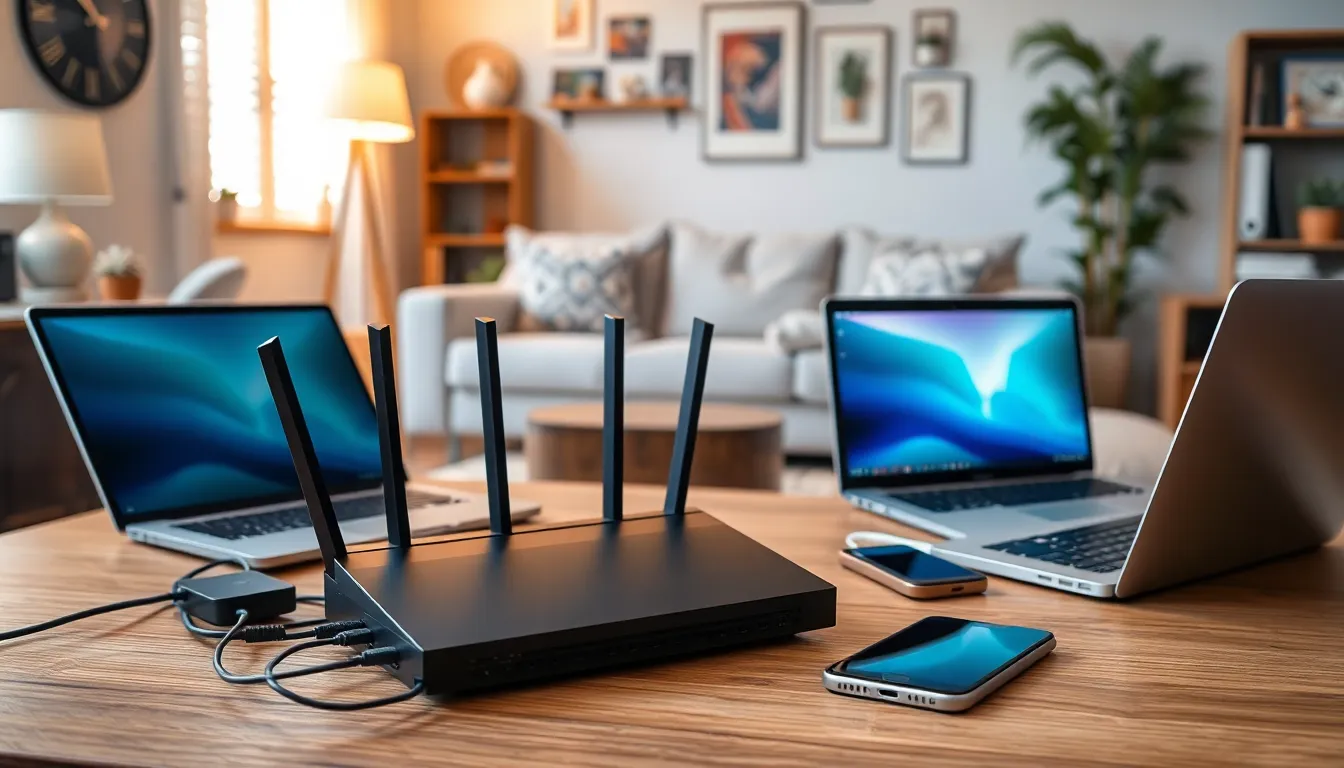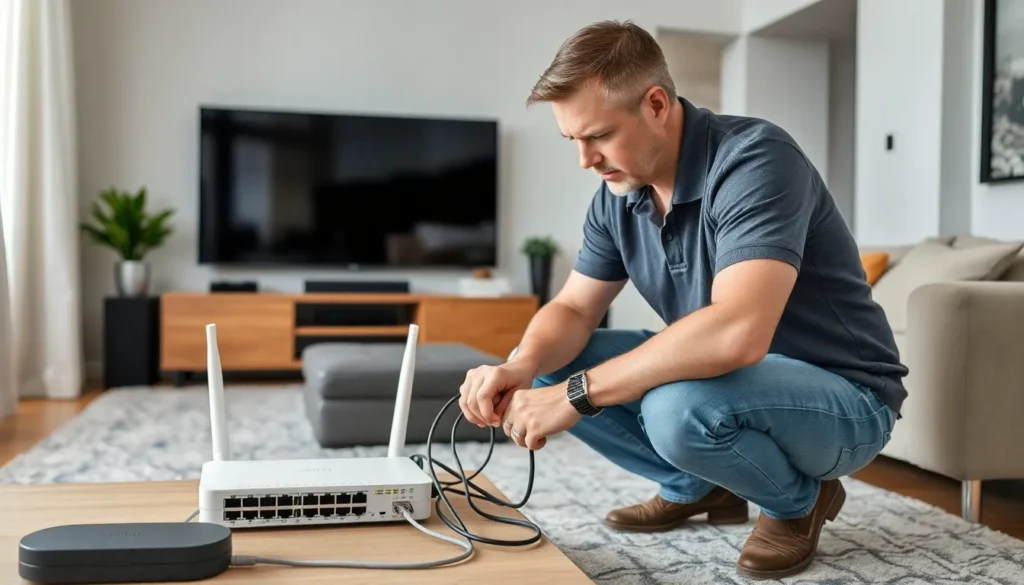In today’s digital age, a well-designed home network is as essential as a good cup of coffee—without it, everything just feels a bit off. Imagine streaming your favorite show while your kids game online, all without a hiccup. Sounds dreamy, right? But without the right setup, it can quickly turn into a buffering nightmare that leaves everyone on edge.
Crafting the perfect home network isn’t just for tech wizards; it’s for anyone who wants a seamless connection. From choosing the right router to placing it in the perfect spot, every detail counts. So grab your favorite snack and get ready to dive into the world of home network design. It’s time to turn that tangled mess of wires into a smooth, efficient system that even your grandma could work.
Understanding Home Network Design
Home network design involves planning and implementing a system that supports various digital needs in the household. A thoughtful approach enhances connectivity and user experience.
Importance of Home Network Design
A well-designed home network boosts efficiency for activities like streaming, gaming, and remote work. Seamless connectivity minimizes interruptions, allowing devices to communicate effectively. Users experience reduced latency and buffering, enhancing overall satisfaction. Secure connections protect personal information, reducing vulnerability to cyber threats. Proper design simplifies troubleshooting, making it easier to resolve connectivity issues.
Common Components of a Home Network
Key components of a home network include routers, switches, and access points. Routers connect multiple devices to the internet and manage traffic between them. Switches expand connectivity by linking multiple wired devices. Access points extend wireless coverage, ensuring all areas of a home receive signals. Ethernet cables enhance speed and reliability by providing stable connections for stationary devices. Firewalls safeguard networks against unauthorized access, adding an extra layer of security.
Types of Home Networks

Understanding the types of home networks helps in selecting the right setup. They primarily fall into wired and wireless categories, along with peer-to-peer and client-server configurations.
Wired vs. Wireless Networks
Wired networks use physical cables for connections. This setup offers higher speeds and more stable connections, ideal for activities like gaming or streaming. Ethernet cables are commonly used for direct connections to devices. Wireless networks rely on Wi-Fi for connectivity. They provide flexibility and convenience, allowing devices to connect without being tethered to a specific location. While wireless networks offer ease of access, they may experience interference and reduced speeds due to distance and obstacles. It’s essential to consider the layout and user needs when choosing between wired and wireless options.
Peer-to-Peer vs. Client-Server Networks
Peer-to-peer networks allow devices to connect directly with each other. This decentralized structure simplifies file sharing and resources without needing a central server. Ideal scenarios for peer-to-peer setups include small households where limited devices share files or printers. Client-server networks introduce a central server that manages resources, providing a more organized system. This structure suits larger households or setups needing robust resource management. Client-server networks enable secure user access and detailed traffic management, ensuring effective control of data. Each type has unique benefits depending on the user’s specific needs and network scale.
Designing Your Home Network
Designing a home network involves careful consideration of specific needs and equipment. Understanding the requirements ensures a seamless connection for all devices.
Assessing Your Network Needs
Identifying network needs starts by evaluating the number of devices connected. Smart TVs, tablets, computers, and gaming consoles contribute to overall bandwidth usage. Estimating data demands helps determine the necessary speed and connection type. Analyzing household activities, such as streaming and online gaming, ensures that the network supports those functions without interruptions. Prioritizing certain activities can help allocate bandwidth effectively. Considering the layout of the home also plays a crucial role in delivering adequate coverage to all areas.
Choosing the Right Equipment
Selecting equipment hinges on understanding network requirements. A high-performance router serves as the foundation for any home network. Target routers with dual-band technology to optimize performance and minimize interference. Wired connections via Ethernet cables enhance stability, especially for gaming and streaming. Additional equipment, like switches for expanded connectivity and access points for better coverage, should also be considered. Researching firewalls adds a layer of security essential for protecting personal information. Ensuring equipment compatibility with existing devices fosters a cohesive network environment.
Best Practices for Home Network Design
A well-structured home network requires careful planning and execution. Prioritizing critical components ensures a reliable and secure system.
Security Considerations
Implementing robust security measures protects personal data in a home network. First, updating router firmware regularly minimizes vulnerabilities. Next, enabling WPA3 encryption adds a layer of protection against unauthorized access. Additionally, setting up a guest network limits access for visitors, preventing potential breaches. Using strong, unique passwords for both the router and connected devices further enhances security. Regularly monitoring connected devices helps identify any unusual activity. Lastly, employing a firewall can block malicious traffic, safeguarding sensitive information.
Optimizing Network Performance
Performance optimization significantly enhances user experience. Begin by placing the router in a central location to maximize coverage. Next, choosing dual-band routers reduces congestion by allowing devices to connect to either 2.4 GHz or 5 GHz bands. Using wired connections for bandwidth-intensive devices ensures stable and fast connectivity. Moreover, placing access points strategically increases network reach in larger homes. Regularly testing network speed can identify issues that require attention. Lastly, prioritizing bandwidth for streaming or gaming activities prevents lag during crucial moments.
A well-planned home network is essential for maximizing connectivity and performance in today’s digital landscape. By understanding the unique needs of each household and selecting the right equipment, individuals can create a seamless and secure online experience. Implementing best practices in both design and security will not only enhance daily activities but also protect personal information from potential threats.
Investing time in network design pays off by reducing frustration and ensuring that everyone in the home can enjoy reliable internet access. With the right approach, transforming a chaotic setup into a streamlined system becomes achievable, leading to a more efficient and enjoyable digital lifestyle.













